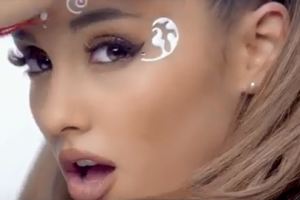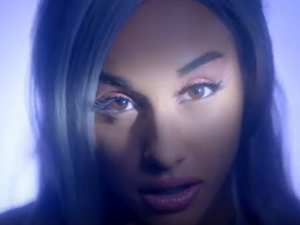Ariana Grande took the charts by storm last Friday when she released her third full-length album, “Dangerous Woman.” The dark, seductive LP hit the number one spot on iTunes in 67 countries and is in contention with Drake’s Views for the number 1 spot on next week’s Billboard 200. Furthermore, the album has been well received by critics, who have lauded Ariana’s experiments with doo-wop (“Moonlight”), reggae (“Side to Side”) and the dark waltz-style that the Weeknd used to storm the charts last year (“Dangerous Woman”). After Ariana’s appearance on the Billboard Music Awards last night giving a riveting performance of a stripped down “Dangerous Woman” and an energized “Into You,” the album is undoubtedly going to succeed.
However, the album we have today is not quite what some had expected. Grande’s successful album launch came at a costly risk that is starting to become more common with superstar artists. It has something to do with lead singles. Generally, an artist’s lead single sets the tone for the album and gets fans and others excited to go see the artist in concert. However, picking the wrong single can make it difficult for an artist to recover, and can make it confusing for fans who often expect a cohesive “message” for an album “era” (an “era” refers to the time spanning the album’s release, single releases and associated tour). With superstar music videos costing hundreds of thousands or even millions of dollars, it’s incredibly important to pick the right single because a successful album launch is at risk.
In October of 2015, Ariana Grande released “Focus” as her first single for her third album—then titled Moonlight (named after the doo-wop ballad mentioned earlier). The funky tune featured spoken vocals from Jamie Foxx; brassy, rhythmic production; and verses belted high in Grande’s vocal register. The music video, which was released on the same day as the single release, featured a lavender-haired Grande, who—clearly inspired by Japanese Manga and high-tech culture—spent most of the video dancing in monochrome rooms, circles and boxes, as if the singer herself was some kind of futuristic object. The chorus lyric, “Focus on me” was aggressive, cartoonish and catchy as hell. “Focus” blasted onto the Billboard Hot 100 at number 7: a debut that made Grande the first ever artist to have his or her first three lead singles (“My Way,” “Problem,” and “Focus”) debut in the top 10. This was no easy feat, and on a micro-level (song sales), this would have made a great start to the album.
However, there was a big issue with “Focus” in terms of setting the tone for the next album. The issue with “Focus,” which free-fell from the charts weeks after its release, was that it was quickly regarded as re-hashed material. It was seen as neither 1.) an exciting foray into a new musical side of Grande, which would be expected for a new solo project or 2.) surrounded by other elements (performances, music videos) that would capture interest. More specifically the issues were the following:
- Musically speaking, “Focus” wasn’t breaking new ground for Grande at all. In fact, it barely drifted from Grande’s previous “Problem”—her number 2 single in 2014 that sold 6 million copies. Billboard, usually a huge proponent of Grande, commented upon the single’s release that “Grande ha[d] never released a less-than-great single, until… ‘Focus’, a rehash of 2014’s ‘Problem’.” Ouch. These three elements in the song are essentially the same:
i. The belted verses. When Ariana sings “Just come and get it let them say what they say / Cause I’m about to put the night away,” in “Focus,” she stretches her chest voice for dramatic effect. The same effect is in “Problem” on the lyrics “Head in the clouds got no weight on my shoulder / I should be wiser and realize that I’ve got.”
ii. The fake-out chorus, featuring a male spoken vocal. It happens in the choruses of both songs: “Focus on me” versus “I got one less problem without ya.”
iii. The jazzy production elements. Finally both tunes had jazzy production elements, including both brass and sax. These elements pop up in the bridge of “Focus” and the opening of “Problem.” - The music video was a continuation of the aesthetic from Grande’s previous album, “My Everything.” Take a look at this still from “Break Free” and notice that Grande is made to look otherworldly and futuristic. The fantastical arc is continued in “Focus” in which Grande sports her dyed hair and is severely dwarfed by many of the spaces she dances in. Here’s Grande in “Break Free”:

Versus Grande’s cartoonish appearance for “Focus”:

“Focus” was a problem. It’s fine for an artist to continue down a similar path musically or stylistically—after all, most of us love Grande for her incredible set of pipes and catchy dance numbers. However, when you release essentially the same song twice with the same types of visuals, it makes it tough to understand why fans would want to buy an album.
For these reasons, Grande and team decided to start fresh in January, announcing a “new” lead single, “Dangerous Woman” and changing the title of the album from Moonlight to Dangerous Woman as well. Furthermore, Grande removed “Focus” from the American version of the album entirely, leaving “Focus” as an albumless release (albeit one with 486 million views on Youtube). Grande slashed months of marketing hype around her album, and replaced it with a new campaign that would right the wrongs of “Focus” and start Dangerous Woman on the right foot. She and her team attacked both elements that made “Focus” a weak lead both in a musical and marketing sense. Here’s how:
- The song “Dangerous Woman” provides us with a totally different and exciting musical direction for Grande: arena rock. The production is so subtle, so barely-there, that the song never strays from Grande’s vocal prowess. Grande shows off her trained head voice in the verses and belts and soars into her muscular upper register. During the instrumental break, Grande reaches for the same notes as the solo guitar, bristling against the sound waves with her Mariah Carey-esque whistle register. When she sings “I’m locked and loaded” in the opening verse, Grande is preparing to shoot off into the stratosphere with that incredible voice. In short, Grande gives us pipes and class—the things we love about her—and does it in a new genre-blend that we didn’t expect.
- Grande’s music videos for “Dangerous Woman” are stripped-down and make her the center of attention. Instead of being boxed into various shapes like in “Focus”, Grande’s presence is the opposite of that level of commercial; in the first video, Grande wears her naturally brunette hair down and wears a single outfit throughout. The second is a stunning acapella video which reiterates Grande’s skills and reaffirms her often displaced humor; it’s nice to see Grande laughing and playing air guitar to her own song while showing off her vocals in a one-take video.
For Grande, it seems that the strategy to axe “Focus” worked. Of course, Grande is a superstar with major financial backing from Republic records. Her ability to nix an entire marketing plan is one exclusively available to highly established and well-funded artists. Rihanna recently did the same thing, scrapping “FourFive Seconds,” “Bitch Better Have My Money” and “American Oxygen” for “Work” which better showcased the nontraditional roots of her latest album, Anti. With smaller artists coming after Spotify and major record labels for issues with inequality, it will be interesting to see how this type of move stratifies the market. With stars like Grande and Rihanna able to fix their mistakes (and costly ones at that), it will likely make it even tougher for low-budget artists to break into the mainstream.
~Shane

